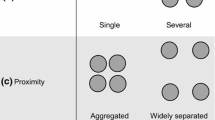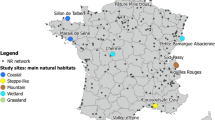Abstract
Our refuge design strategy involves a landscape approach formulated to complement existing management efforts and employ restoration in the heavily degraded Kankakee River watershed in northeastern Indiana and northwestern Illinois. The watershed historically contained an approximately 400,000 ha wetland (Grand Marsh), a diverse riverine system, oak savanna, and prairie. Today only fragments of these habitats remain. The U.S. Fish and Wildlife Service developed a preliminary project proposal (PPP) during the summer of 1996 to protect and restore habitat within the watershed by establishing the Grand Kankakee Marsh National Wildlife Refuge. The Indiana and Illinois Gap Analysis projects provided the resources to move beyond the expert workshop approach to a data-driven method for initial reserve design. Using visual analysis of various Gap Analysis data layers, we established ‘Focus Areas’ that formed the basis for the Environmental Assessment and the Economic Impact Study required under the National Environmental Policy Act (NEPA). We have initiated Phase II of the reserve design analysis using preliminary results of the Indiana Gap Analysis project and C-Plan software in conjunction with the New South Wales National Parks and Wildlife Service.
Similar content being viewed by others
References
Betz, R. F. 1978. The prairies of Indiana. In Proceedings of the Fifth Midwest Prairie Conference. Iowa State University, Ames, pp. 25–31, Iowa.
Clark, F. S., Magnuson, T. and Slusher, R. B. 1998. Draft environmental assessment: proposed Grand Kankakee Marsh National Wildlife Refuge. U.S. Fish and Wildlife Service, 186 pp.
Csuti, B., Polasky, S., Williams, P. H., Pressey, R. L., Camm, J. D., Kershaw, M., Kiester, A. R., Downs, B., Hamilton, R., Huso, M. and Sahr, K. 1997. A comparison of reserve selection algorithms using data on terrestrial vertebrates in Oregon. Biol. Cons. 80: 83–97.
Dahl, T. E. 1990. Wetlands losses in the United States 1780's to 1980's. U.S. Department of the Interior, Fish and Wildlife Service, Washingtion, D.C., 21 pp.
Indiana Department of Natural Resources, Division of Water. 1990. Water resource availability in the Kankakee River basin, Indiana. State of Indiana, Indianapolis, Indiana.
Johns, D. and Soule, M. 1995. Getting from here to there: an outline of theWildlands reserve design process. Wild Earth 5(4): 32–46.
Leach, M. K. and L. Ross, eds. 1995. Midwest oak ecosystems recovery plan: a call to action. Midwest Oak Savanna and Woodland Ecosystems Conference. Springfield, Missouri.
Mausel, P. W. 1998. Project Final Report-31 March 1998: Identification of classes of cropland soil drainage/wetness in the Kankakee watershed using computer analyzed Landsat TM data and selected digital data bases within a GIS. Submitted to the Indiana Department of Natural Resources.
Meyer, A. 1936. The Kankakee ‘marsh’ of northern Indiana and Illinois. Reprinted from the Papers of the Michigan Academy of Science, Arts and Letters, Vol. XXI, 1935.
Noss, R. F. 1983. A regional landscape approach to maintain diversity. Bioscience 33: 700–706.
Noss, R. F. and Harris, L. D. 1986. Nodes, Networks, and MUMs: preserving diversity at all scales. Environ. Manag. 10(3): 299–309.
Nuzzo, V. A. 1986. Extent and status of midwest oak savanna: presettlement and 1985. Nat. Areas J. 6(2): 6–36.
Packard, S. and Mutel, C. F. 1997. The tallgrass restoration handbook: for prairies, savannas, and woodlands. Island Press. Washington, D.C. 463 pp.
Pressey, R. L. and Taffs, K. H. In press. Priority conservation areas: a definition for the real world applied to western New South Wales using explicitly uncertain data on risk of habitat loss. Submitted to Biological Conservation.
Pressey, R. L., Johnson, I. R., and Wilson, P. D. 1994. Shades of irreplaceability: towards a measure of the contribution of sites to a reservation goal. Biodiversity and Conservation 3: 242–262.
Pressey, R. L., Ferrier, S., Hutchinson, C. D., Sivertsen, D. P. and Manion, G. 1995. Planning for negotiation: using an interactive geographic information system to explore alternative protected area networks. In Nature Conservation 4: the Role of Networks pp. 23–33. Edited by D. A. Saunders, J. L. Craig and E. M. Mattiske. Surrey Beatty and Sons, Sydney. pp. 23–33.
Pressey, R. L. 1998. Algorithms, politics and timber: an example of the role of science in a public, political negotiation process over new conservation areas in production forests. In Ecology for everyone: communicating ecology to scientists, the public and the politicians. pp. 73–87. Edited by R. Willis and R. Hobbs. Surrey Beatty and Sons, Sydney.
Shively, G., McNamara, K., McCoy, S. and Mills, B. 1998. Economic Impact Assessment of the proposed Grand Kankakee Marsh National Wildlife Refuge in Indiana and Illinois. Appendix II. In Draft environmental assessment: proposed Grand Kankakee Marsh National Wildlife Refuge. U.S. Fish and Wildlife Service, 186 pp.
Soule, M. E. and Simberloff, D. 1986. What do genetics and ecology tell us about the design of nature reserves? Biological Conservation 35: 19–40.
TNC. 1997. The Fair Oaks Farms Restoration in Context of the Kankakee Sands Macrosite (draft report accompanying TNC's briefing on the restoration goals of the Fair Oaks Farms Site. Unpublished.
U.S. Fish and Wildlife Service. 1998. Division of Realty guide for landowners: U.S. Fish and Wildlife Service, U.S. Fish and Wildlife Service Homepage, http://www.fws.gov/r9realty/guide.html.
Author information
Authors and Affiliations
Rights and permissions
About this article
Cite this article
Clark, F.S., Slusher, R.B. Using spatial analysis to drive reserve design: a case study of a national wildlife refuge in Indiana and Illinois (USA). Landscape Ecology 15, 75–84 (2000). https://doi.org/10.1023/A:1008121528773
Issue Date:
DOI: https://doi.org/10.1023/A:1008121528773




